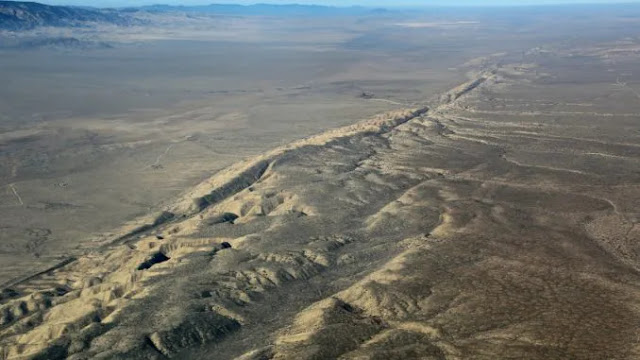
- 2020-08-11
- 0.0 Reitingas
- 834 Peržiūros
- Aptarti
A swarm of small earthquakes in California is being closely monitored to see if it might raise the chance of a much larger event on the San Andreas fault.
Dozens of minor earthquakes hit just south of the dangerous San Andreas fault in a matter of hours, prompting concerns among seismologists that it may trigger a megaquake in the near future.
USGS research geophysicist Morgan Page said that Monday’s swarm “does increase the chance of a big earthquake on the San Andreas somewhat, so it’s definitely something to watch.”
It’s only the fourth time in the 88 years of modern records that such a swarm has occurred in this part of California
RT reports: The largest temblor in Monday’s swarm was a magnitude 4.6, while there were multiple magnitude 3 quakes, all of which struck in an area known as the Brawley Seismic Zone, wedged between the San Andreas Fault and the Imperial Fault which goes all the way south to Mexico.
Salton Sea earthquake swarm update: So far there's been 90+ quakes since 8:56am PT with three quakes >M4. Largest in the sequence so far is still the M4.6 quake. These swarms can generate 100s of quakes, but typically they settle down after a few days. pic.twitter.com/nixsdcD8tr
— Brian OLSON-19 (@mrbrianolson) August 10, 2020
Similar swarms have been recorded in the past and typically last approximately one week but with each new swarm, tensions mount that the Big One could hit at any moment.
“We have faults that are building up strain all the time,” said Zachary Ross, a seismologist at Caltech who studies these swarms.
At present, there is a one in 10,000 chance of a magnitude 7 and above quake hitting the southern San Andreas area.
There is roughly a one in five chance of one hitting in the next three decades and a one in a hundred chance of a magnitude 7 and above quake occurring in the next week, a similar level of risk in the aftermath of another such swarm in 2016.
“It’s definitely something to watch,” said USGS research geophysicist Morgan Page, cuationing that there was no immediate need for panic, just vigilance.
Monday’s swarm is only the fourth time in the 88 years since official records began that such a swarm has struck this area. Meanwhile, the San Andreas fault has not ruptured in the vicinity since 1690 and it is estimated to rupture once every 250 years or so.
Today’s #saltonsea #earthquake swarm in CA raises the probability of larger earthquakes in the #sanandreas region. Medium-sized earthquakes can cause damage too; visit our aftershock forecast for more info and Drop, Cover and Hold on if you feel shaking. https://t.co/6JHVNt2y3w
— USGS (@USGS) August 11, 2020
While seismologists are concerned, they would be far more concerned were the swarm to shift northwards toward the fault. That didn’t stop people from posting doomsdayprophecies in response to the USGS, though others were a little more playful.
The last true mega quake to occur in Southern California was a magnitude 7.8 in 1857. However, just last year, on July 5, a magnitude 7.1 quake struck the Golden State, causing billions of dollars in damage.
Pasaulio naujienas kitaip... skaitykite Paranormal Telegram, FB ir X(twitter) kanale...kadangi jau perskaitėte šį straipsnį iki pabaigos, prašome Jus prisidėti prie šio darbo. Skaitykite „Paranormal.lt“ ir toliau, skirdami kad ir nedidelę paramos sumą. Paremti galite Paypal arba SMS. Kaip tai padaryti? Iš anksto dėkojame už paramą! Nepamirškite pasidalinti patikusiais tekstais su savo draugais ir pažįstamais.
Turite savo nuomone, tapk autoriumi, prisijunk ir rašykite bloge. Dalinkitės receptais, sveikatos patarimais, nutikimais, susidūrėte su nekasdieniškais reiškiniais. Galite išversti iš užsienio kalbos, talpinkite su nuoroda. Laukiame Jūsų straipsnių, naujienų, apžvalgų ar istorijų!
Susijusios naujienos
Būkite pirmi, kurie pasidalins savo nuomonėmis su kitais.
Skaityti daugiau
Skaityti daugiau
Skaityti daugiau
Skaityti daugiau
Skaityti daugiau
Skaityti daugiau
